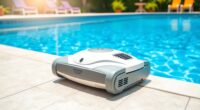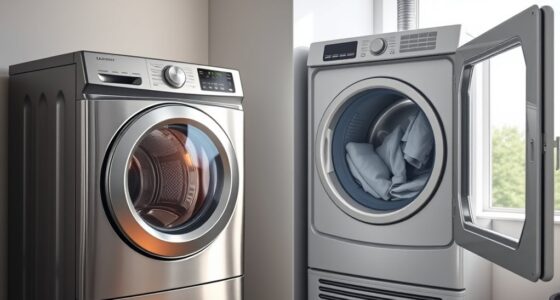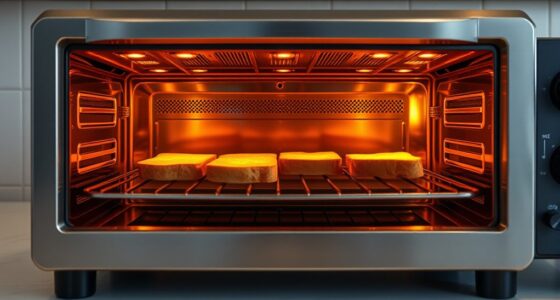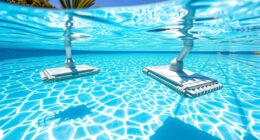To store your suction pool cleaner during the off-season, start by thoroughly cleaning it with fresh water, removing debris, and inspecting for damage. Store it in a cool, dry place away from sunlight, and coil hoses loosely to prevent kinks. Fully charge the batteries or remove them if possible. Check manufacturer instructions for robotic parts, and perform a quick test run before reusing. For detailed steps, keep exploring to guarantee your equipment stays in excellent shape.
Key Takeaways
- Clean and rinse the suction cleaner thoroughly, removing all dirt, debris, and residual chemicals before storage.
- Store in a cool, dry location away from direct sunlight, moisture, and temperature fluctuations.
- Fully charge the battery and run a cleaning cycle; remove and store batteries separately if possible.
- Coil hoses loosely to prevent kinks and inspect for damage or wear, repairing as needed.
- Reinspect, rinse, and perform a test run before pool reopening to ensure optimal operation.
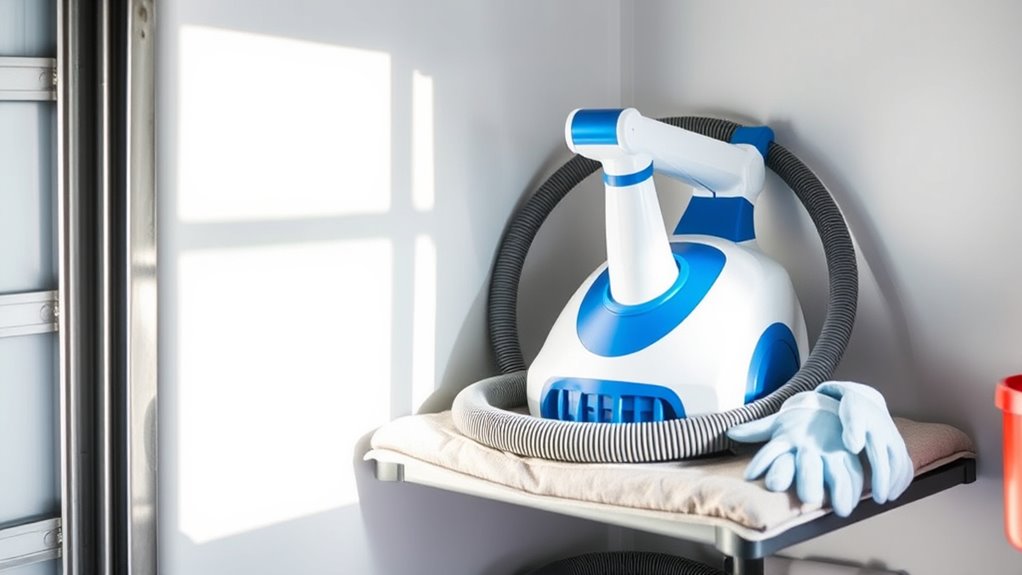
As the seasons change, giving your pool cleaner the right care is essential to keep it functioning properly year-round. When it’s time to store your suction pool cleaner for the off-season, proper preparation ensures it stays in top shape for when you reopen your pool. The first step is to thoroughly clean your cleaner, removing any dirt, debris, or residual pool chemicals. Rinse it with fresh water, paying close attention to brushes, hoses, and nozzles. This prevents buildup that could cause issues later. Once cleaned, inspect the device for any signs of wear or damage, and repair or replace parts as needed. Proper storage is critical, so find a cool, dry place away from direct sunlight and extreme temperatures. Avoid leaving it in the garage or shed where temperature fluctuations can degrade components over time.
If your pool has a robotic maintenance system, follow specific instructions for storing it during the off-season. Many robotic cleaners require a complete charge before storage and should be stored in a fully charged state to preserve battery health. Some models recommend running a cleaning cycle prior to storage to clear out any remaining debris and prevent mold or mildew growth. Additionally, consider removing batteries if possible, and storing them in a cool, dry environment. When it comes to chemical balancing, verify your pool water is properly balanced before shutting down for the season. This prevents algae growth and corrosion that could damage your equipment during storage. Maintain proper pH, alkalinity, and sanitizer levels, and consider adding a winterizing chemical if needed, depending on your climate.
During storage, periodically check on your equipment if possible. For robotic cleaners, ensure no moisture has accumulated inside the unit, and if your model has filters or brushes, remove and clean them once more before storing. For suction cleaners, coil hoses loosely to prevent kinks and cracks. This care helps prevent mold, corrosion, or mechanical issues that could be costly to repair later. When reusing the pool in the spring, inspect everything again, rinse off any dust or debris, and perform a full test run. Rebalance your pool’s chemicals, ensuring water quality is perfect before reintroducing your cleaner. Taking these steps might seem meticulous, but they’re crucial to prolong the lifespan of your pool equipment, especially your robotic maintenance systems and suction cleaners, so you can enjoy a pristine pool season after season.
Frequently Asked Questions
Can I Leave the Cleaner Outside During Winter?
You shouldn’t leave your suction pool cleaner outside during winter weather. Cold temperatures and harsh conditions can damage the device and reduce its lifespan. To guarantee outdoor protection, it’s best to store it in a dry, sheltered area away from snow and ice. Proper storage helps prevent freezing and corrosion, keeping your cleaner in good shape for next season. Always follow manufacturer instructions for peak winter storage.
What Tools Are Needed for Storage?
You need a few essential tools for proper storage: sturdy storage containers to keep your cleaner safe, cleaning supplies to guarantee it’s spotless before storage, and a soft brush or cloth to remove debris. Gather these items to protect your equipment, prevent damage, and keep everything organized. With the right tools, you’ll make storage simple and ensure your suction pool cleaner stays in top condition for next season.
How Often Should I Inspect the Cleaner During Storage?
You should inspect your cleaner at least once a month during storage. This guarantees it remains in good condition and ready for use. Follow a thorough storage checklist, checking for any signs of wear, damage, or mold. Regular inspections help catch issues early, preventing costly repairs later. Keep your cleaner clean and dry, and store it in a cool, dry place to prolong its lifespan and ensure peak performance when needed.
Is It Necessary to Lubricate Parts Before Storage?
Lubrication maintenance is essential before storage to keep your suction pool cleaner in good condition. You should apply a suitable lubricant to moving parts, like wheels and brushes, to prevent rust and ensure smooth operation later. Proper storage preparation involves cleaning and lubricating your cleaner, so it’s ready for the next season. Skipping this step can lead to corrosion or parts seizing up, making future maintenance more difficult.
How Do I Troubleshoot Storage-Related Issues?
When troubleshooting storage-related issues, you want to check your storage container for proper sealing, adequate ventilation, and cleanliness. Make certain your cleaning supplies are dry and free of debris to prevent mold or corrosion. Inspect hoses and filters for damage or blockages, and verify that all parts are correctly assembled. By maintaining a tidy, dry, and organized storage space, you can prevent problems and keep your suction pool cleaner in top shape.
Conclusion
By properly storing your suction pool cleaner during the off-season, you’re setting yourself up for an easier, hassle-free start when swimming season returns. Take the time to clean, dry, and store your cleaner correctly—don’t leave it to gather dust or face damage. Remember, a stitch in time saves nine; a little effort now prevents bigger headaches later. With the right care, your pool cleaner will be ready to go when you need it most.

